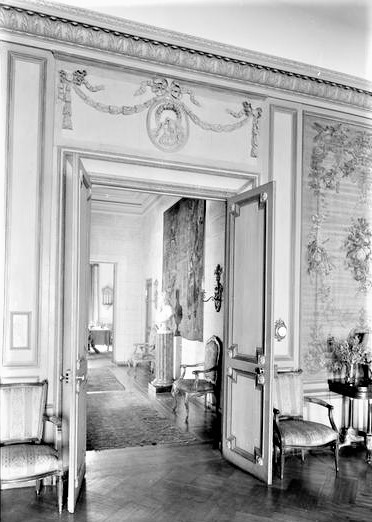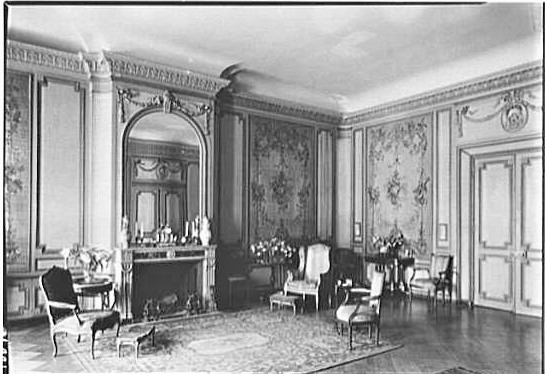A high brownstone stoop originally rose to the entrance, now the second floor window to the right.
In 1852 the family of Oliver De Forest Grant lived in the recently completed mansion at 11 Gramercy Park, in one of the city's most exclusive enclaves. They counted among their neighbors the internationally known Dr. Valentine Mott, politician Samuel Tilden, brothers Cyrus and Dudley Field, Mayor James Harper, Sr., and influential attorney James W. Gerard.
Grant was a partner with William Barton in the banking firm of Grant & Barton. He was also involved in the New Jersey Locomotive & Machine Co. He and his wife, the former Eliza Adeline Suydam, had four children, James Henderson, David Beach, Richard Suydam, and Adele. A fifth, George De Forest Grant, would be born in 1852.
The Grant's 26-foot-wide Greek Revival home was three stories high with an squat attic level. It sat high above an English basement. A full-width cast iron balcony fronted the floor-to-ceiling height French parlor windows, which wore classical pediments.
The Grant house, with its parlor floor intact, is the third from the left in this 1877 etching. from the collection of the New York Public Library.
Also living in the house were Oliver's parents, Josiah Curtis and Rhoda Wheeler Grant. Rhoda died at the age of 76 on March 19, 1857 and, as was customary, her funeral was held in the parlor three days later. Two years later it was the scene of another funeral. Twelve-year-old Adele died on November 21, 1859.
Despite the initial wave of patriotic enrollments following the outbreak of Civil War in 1861, by 1863 Union troops were dangerously depleted. On July 11, the nation’s first attempt at a military draft played out in New York with a lottery. When the 1,200 chosen names were published, it was obvious that the city’s poor and immigrant population formed the great majority—the wealthy had bought exemptions or used their political power to circumvent the draft.
But that was not the case with the Grant family. Among the names pulled on August 25 were James H. Grant and his brother Richard. James would attain the rank of Lieutenant Colonel. Happily, both men returned home to Gramercy Park following the conflict.
Josiah Curtis Grant lived to be 91. He died in the house on October 27, 1865 and, as had been the case with his wife, his funeral was held here two days later.
At the time of his death, trains were becoming an increasingly crucial means of transportation. On March 21, 1866, the New Jersey Locomotive & Machine Co. was renamed The Grant Locomotive Works with Oliver De Forest Grant as its president. The same year larger factories in Patterson, New Jersey were constructed.
That year James Henderson Grant traveled to Japan, where he was engaged in the brokerage business for several years. It is doubtful, therefore, that he attended the funeral of his father in the Gramercy Park house. Oliver De Forest Grant caught cold in the fall of 1869. It advanced to pneumonia and he died on November 24 at the age of 62.
While David and Richard had joined their father in the Grant Locomotive Works, James continued to seek his own fortune. Upon returning to America he struck out to the Far West. It is unclear exactly what drew him there, but railroads and gold, silver and copper mines were booming. He died in Denver, Colorado on April 13, 1880, at the age of 42. His body was brought back to New York for burial in the Grant-Suydam plot in Greenwood Cemetery.
Eliza died in 1891. Bachelors Richard and George lived on in their childhood home. While both were listed as members of the Grant & Co. brokerage house, it seems that Richard was the more serious in his profession. A contemporary said of George:
He has never adopted any profession but has taken very kindly and enthusiastically to sport. He is a good shot, a good whip and a good fellow. He has a bluff, jovial manner and looks upon all things with that careless, yet not unkindly indifference which is possible only to the wealthy and contented.
As some point George's and Richard's nephew Douglas Stewart Grant moved in. (The son of David Beach Grant, his sister Adele Beach Grant had married George Devereux de Vere Capell, 7th Earl of Essex, on December 14, 1893.) The New York Times said the three Grants "kept bachelor hall there."
Douglas left the Gramercy Park house following his marriage to Isabelle Isham Scott. They moved to England where he listed his occupation as "private means." Isabelle sailed back to her parent's Newport mansion in 1900, where she filed for divorce.
George De Forest Grant died in St. Augustine, Florida on April 5, 1905. His body was transported back to the Gramercy Park house for his funeral.
Never married, Richard remained at 11 Gramercy Park with his staff of servants until his death at the age of 94 on December 16, 1912. His social prominence was reflected in his memberships in the exclusive Metropolitan, University, New York Yacht, Downtown and Racquet Clubs.
Five years later, on August 15, 1917, The New York Times reported, "C. W. Sherwood is the buyer of the private dwelling 11 Gramercy Park. The structure will be altered for bachelor apartments." Charles Sherwood hired architect John E. Nitchie to do the alterations that would cost the equivalent of $565,000 in today's money. The stoop was removed, the entrance lowered to the former basement level, and the former doorway was altered to a window that seamlessly matched the originals. No other significant changes were made to the exterior.
Although technically termed "bachelor" apartments, they filled with well-to-do occupants of both sexes. Harriet O. Berry shared an apartment with her sister. When she married John Aitken on April 23, 1920, The Sun mentioned that the groom "inherited more than $1,000,000 from his father."
Also living here were Nicholas Biddle and his wife, the former Elizabeth LeRoy Emmet. Biddle was a member of an old Philadelphia family and had been a close friend and business associate of John Jacob Astor IV who lost his life on the RMS Titanic. Elizabeth, according to The Evening Telegram in 1923, was a "descendant of a family famous in Irish history."
But perhaps none of the residents would shine the social spotlight on 11 Gramercy Park more than Samuel Latham Mitchell Barlow and his wife, Ernesta Beaux. The marriage was the second for both of them.
Barlow's marriage to Evelyn Harris Brown ended in divorce in 1925. He married Ernesta Beaux in 1928. Born Aimee Ernesta Drinker, she had changed her name following her divorce from Ambassador William C. Bullitt.
Barlow was a pianist, composer and art critic. Ernesta was an interior decorator, as well as a writer, and lecturer on social issues. Entertainments in the Gramercy Park apartments almost always involved music. On February 16, 1937, for instance, The New York Sun reported that the couple would be hosting a "Russian party" for Catherine Drinker Bowen and Madame Barbara von Meck. "The guests to be honored are the co-authors of the current Book-of-the-Month choice, 'Beloved Friend," the story of Tschaikowsky [sic] and Nadejda von Meck."
The article said, "Guests on Wednesday evening will be entertained by excerpts from to of Tschaikowsky's [sic] most celebrated operas, presented in costume by two well known singers from the Art of Musical Russia Company."
A Houdin bust sat in a niche in the upper hall of the Barlow apartment. photo by Samuel H. Gottscho from the collection of the Library of Congress.
While vacationing along the Mediterranean in the 1920's Samuel Barlow had become enchanted with a medieval French village above Cape Ferrat on the French Riveria. After negotiating with the mayor, he purchased approximately a dozen vintage houses on the cliffside. After demolishing them, he started construction on a sprawling chateau. It was not only his and Ernesta's European retreat, but a destination for artists and intellectuals.
Musical benefits were often held in the Barlow apartments. On February 27, 1942 The New York Times reported, "Eight pianists will perform compositions from the album 'Homage to Paderewski' at the concert to be given tonight...at the home of Mr. and Mrs. Samuel L. M. Barlow, 11 Gramercy Park, for the benefit of the Paderewski Memorial Hospital in Edinburgh, Scotland."
A view from the living room, through the second floor stair hall, to the dining room in the Barlow apartment. photo by Samuel H. Gottscho from the collection of the Library of Congress.
A much different event was held here in the winter of 1956. On December 12, The New York Times announced, "The first of a series of four teas and fashion shows for the wives of delegates to the United Nations General Assembly will be held Wednesday in the home of Mr. and Mrs. Samuel L. M. Barlow of 11 Gramercy Park."
The couple remained in the apartment until 1971. When the property was sold in September 1992, The New York Times recalled, "For 50 years...Mr. Barlow and his wife, Ernesta, held musical gatherings in their home on Wednesday nights." In his 1984 history, Gramercy Park, author Stephen Garmey called them, "elegant, serious musicales." The New York Times article mentioned, "The Juilliard String Quartet often played at these events, to guests seated on gilt chairs in the drawing room.
The new owner, John Benitez, had purchased the vintage property for $1.45 million (around $2.67 million today), announcing his intentions for "a historic restoration." And, indeed, the resultant work is pristine. There are currently three residential units in the former Grant mansion.
photographs by the author
LaptrinhX.com has no authorization to reuse the content of this blog








Worth a footnote that the Barlows were married at the home of her aunt, the painter Cecilia Beaux. Ernesta Barlow was one of her aunt's favorite models over the years, including the lovely "Ernesta and Nurse," depicting a very young Ernesta.
ReplyDelete